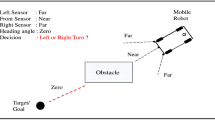Abstract
This paper develops an intelligent method called supervisory recurrent fuzzy neural network (SRFNN) control to deal with the vehicle collision avoidance system (VCAS), which is an uncertain nonlinear model-free system. This SRFNN control system is composed of a recurrent fuzzy neural network (RFNN) controller and a supervisory controller. The RFNN controller is investigated to mimic an ideal controller, and the supervisory controller is designed to compensate for the approximation error between the RFNN controller and the ideal controller. This SRFNN control is employed to keep the VCAS within a safety range to avoid traffic accidences. The simulation results show the performance and effectiveness of the proposed control system are better than that obtained by formal formula-based control.




Similar content being viewed by others
References
Matsuda S (1997) Vehicle collision preventing system. U. S. patent US 5,699,040
Aufrere R, Gowdy J, Mertz C, Thorpe C, Wang CC, Yata T (2003) Perception for collision avoidance and autonomous driving. Mechatronics 13:1149–1161
Mar J, Lin FJ (2001) An ANFIS controller for the car-following collision prevention system. IEEE Trans Vehi Tech 50(4):1106–1113
Ganji B, Kouzani AZ (2012) Combined quasi-static backward modeling and look-ahead fuzzy control of vehicles. Expert Syst Appl 39(1):223–233
Milanés V, Pérez J, Godoy J, Onieva E (2012) A fuzzy aid rear-end collision warning/avoidance system. Expert Syst Appl 39(10):9097–9107
Qi Z, Tian Y, Shi Y (2012) Efficient railway tracks detection and turnouts recognition method using HOG features. Neural Comput Appl. doi:10.1007/s00521-012-0846-0
Mon YJ, Chen RH, Luo KT (2002) Fuzzy logic based vehicle collision avoidance warning device. U. S. patent US 6,430,506 B1
Mon YJ (2005) Integrated automotive safety system design by a fuzzy-neural-network. Int J Veh Auton Syst 3(2/3/4):176–197
Ge SS, Hang CC, Zhang T (1999) Adaptive neural network control of nonlinear systems by state and output feedback. IEEE Trans Syst Man Cybern Part B Cybern 29:818–828
Zhihong M, Wu HR, Palaniswami M (1998) An adaptive tracking controller using neural networks for a class of nonlinear systems. IEEE Trans Neural Netw 9:947–1031
Chen YC, Teng CC (1995) A model reference control structure using a fuzzy neural network. Fuzzy Sets Syst 73:291–312
Lin CT, Lee CSG (1996) Neural fuzzy systems: a neural-fuzzy synergism to intelligent systems. Prentice-Hall, Englewood Cliffs, NJ
Ku CC, Lee KY (1995) Diagonal recurrent neural networks for dynamic systems control. IEEE Trans Neural Netw 6:144–156
Lee CH, Teng CC (2000) Identification and control of dynamic systems using recurrent fuzzy neural networks. IEEE Trans Fuzzy Syst 8:349–366
Lin FJ, Wai RJ (2001) Hybrid control using recurrent fuzzy neural network for linear-induction motor servo drive. IEEE Trans Fuzzy Syst 9:102–115
Aliev RA, Guirimov BG, Fazlollahi B, Aliev RR (2009) Evolutionary algorithm-based learning of fuzzy neural networks. Part 2: recurrent fuzzy neural networks. Fuzzy Sets Syst 160:2553–2566
Lin CM, Hsu CF (2002) Recurrent neural network adaptive control of wing-rock motion. J Guid Control Dyn 25:1163–1165
Mon YJ, Lin CM, Leng CH (2008) Recurrent fuzzy neural network control for MIMO nonlinear systems. Intell Autom Soft Comput 14(4):395–415
Mon YJ, Lin CM (2012) Supervisory recurrent fuzzy neural network guidance law design for autonomous underwater vehicle. Int J Fuzzy Syst 14(1):54–64
Choi HH (2009) Output feedback stabilization of uncertain fuzzy systems using variable structure system approach. Fuzzy Sets Syst 160:2812–2823
Slotine JJE, Li W (1991) Applied nonlinear control. Prentice-Hall, Englewood Cliffs, NJ
Lin CM, Chen CH (2006) Adaptive RCMAC sliding mode control for uncertain nonlinear systems. Neural Comput Appl 15:253–267
Da F (2008) Fuzzy neural network sliding mode control for long delay time systems based on fuzzy prediction. Neural Comput Appl 17:531–539
Spooner JT, Passino KM (1996) Stable adaptive control using fuzzy systems and neural networks. IEEE Trans Fuzzy Syst 4(3):339–359
Acknowledgment
This paper is partially funded by teacher’s research project of Taoyuan Innovation Institute of Technology.
Author information
Authors and Affiliations
Corresponding author
Rights and permissions
About this article
Cite this article
Mon, YJ., Lin, CM. Supervisory recurrent fuzzy neural network control for vehicle collision avoidance system design. Neural Comput & Applic 21, 2163–2169 (2012). https://doi.org/10.1007/s00521-012-1098-8
Received:
Accepted:
Published:
Issue Date:
DOI: https://doi.org/10.1007/s00521-012-1098-8




